|
Every boater has to clean things on their boat. Scrubbing for hours on end is not fun. So in an effort to make cleaning easier, we offer the following suggestions from various members
of the SJ23 fraternity. (feel
free to send me more ideas. I'll add them to the list). Working with strong chemicals requires taking a few common sense safety precautions. First and foremost, read and follow the directions on the container. An MSDS label is there to inform you. Always wear gloves when using harsh chemicals. The heavy duty gloves designed for caustic chemicals or acids work well. As a alternative use household gloves. The last thing you want is to loose your finger prints through pin hole leaks in latex gloves. Acids do that very well! IMPORTANT, read "SAFETY WARNINGS" below about mixing cleaners! FOUR MUST HAVE SOLVENTS TO KEEP ON BOARD TOP
ACETONE - Use to sanitize a surface prior to applying epoxy or polyester resin. Dries very fast. Can also be used to clean a spill or tools coated with resin. MINERAL SPIRITS - Good for thinning varnish & enamel paints, cleans brushes, wipe up stray polyurethane sealants and general cleanup. VINEGAR - Don't use epoxy without it. This is very effective to clean tools and skin. It may take a few minutes of soaking to soften the epoxy so it can be cleaned with scrubbing. Vinegar can also clean bronze.
Vinegar can also remove the patina from bronze by letting it soak overnight in a 50/50 blend of water & vinegar.
Below is the result of soaking bronze anchor rollers overnight. Cleaned is on the left. |
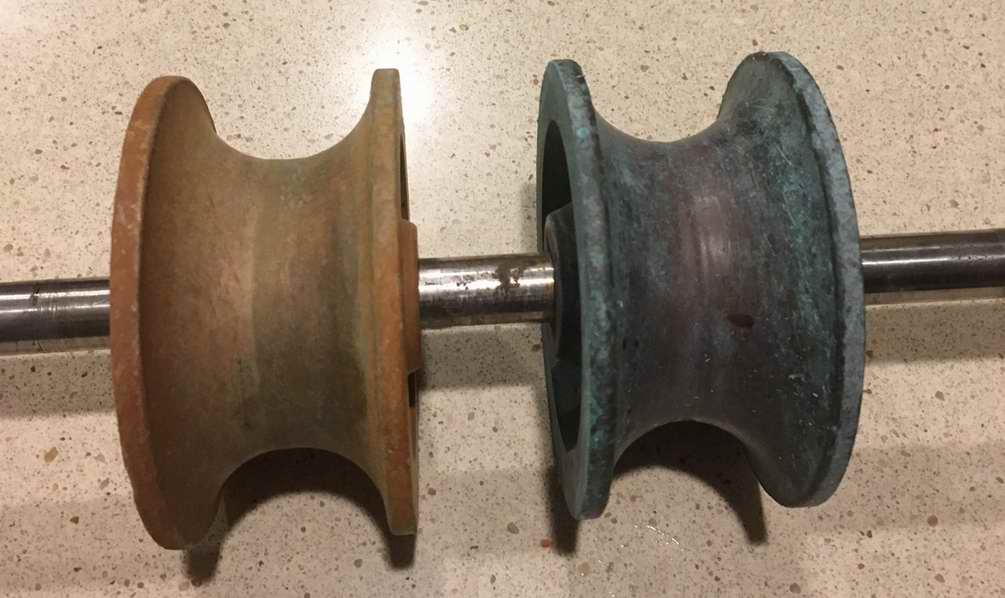
|
XYLENE - Reduces most top side paints, bottom paints, removes a smudge and is perfect to remove fender & black heel marks from gel coat.
SOAP CLEANING SOLUTIONS TOP
-
CAMCO BLACK STREAK REMOVER - Removes black streaks,
bugs, tar, grease, oil & dirt from window trim, gutter rails and
fibreglass hulls.
DENATURED ALCOHOL - A cleaner that is sold at
most any hardware store. This is ethanol with some methanol added to make it poisonous (not taxable as liquor!). ETHER (Engine Starting Fluid) - Use to clean
the cured butyl rubber sealant after you remove the fitting. GOOF-OFF - Is a latex paint remover that is
great for cleaning vinyl fenders. Follow up with a coat of Armor All.
This stuff is really volatile so use in open air. HOME MADE MILDEW CLEANERS
Formula A - 1 qt hot water, 1 tbsp baking soda, 2 tbsp washing soda, 2 tbsp trisodium phosphate (TSP).
Formula B - 1 qt hot water, 2 tbsp baking soda, 2 tbsp Borax, 1 tbsp trisodium phosphate (TSP). PAINT BRUSH CLEANER - (not to be confused with turpentine or mineral spirits).
This stuff is made to clean or restore
a paint brush where the paint has hardened in the bristles. But
it also removes exhaust stains from
fibreglass/gel coat, cleans uncured fibreglass resin or epoxy, is good for cleaning
vinyl and
gel coat stains, is great for removing adhesive left from a label or price sticker,
can remove wax prior to painting or epoxy repair and best of all, it rinses away with water. SCRUBBING BUBBLES BATHROOM CLEANER - Works great on
fibreglass surface and leaves a nice shine. It also works well on Life Lines and the vinyl trim on the
canvas dodger. If you are going to try another bathroom cleaner
be sure it is OK for use on fibreglass. SPRAY NINE - Is excellent for removing a stain
on a vinyl awning or dead bugs from the front of a vehicle. Does not affect paint. Simply spray on, let soak for a few minutes and hose
off with water. For a really stubborn stain use a small brush and some
elbow grease. SOFT SCRUB WITH BLEACH - Used for cleaning lifelines or an
inflatable boat. TSP AND A DOLLOP OF DISH SOAP - Mix the detergent in a bucket of warm water. It cleans a deck better than anything else I've tried. I use this concoction a few times a season.
For the normal deck scrubbing I use Soft Scrub. VANISH TOILET BOWL CLEANER - Cleans scummy boot
stripes and hulls. Especially if you use the gel cleaners. WESLEY'S WHITEWALL CLEANER - Great for removing
bird poo from the deck.
PROTECTIVE COATINGS TOP
-
FUTURE WAX - Returns shine to old fibreglass
non-skid areas.
-
NIKWAX ROPE PROOF - If you want sheets & halyards to stay lighter in the rain and spray, Rope Proof can definitely help. 39% less weight gain after dunking. Subtle but unmistakable improvement in handling and a reduction in snarling. A treatment lasts about a year. Cold weather sailors will find big improvement as treated halyards run free and sheets aren't stuck to the deck. In addition, squeaking on the drum is reduced and the line tends to slip off and run through blocks a bit easier.
-
NIKWAX TECH WASH - Use in the washing machine (front loading) to clean and restore the water proof property if Sunbrella.
-
NIKWAX DOWN WASH - Use in the washing machine (front loading) to restore the water repellence property of hydrophobic or down filled gear. Your down gear will be warmer with an application.
-
PLEDGE FURNITURE POLISH - To
preserve clear vinyl windows. Use the plain stuff not "Lemon Pledge."
-
SUN TAN LOTION WITH SPF 30 - This
stuff does a great job of protecting a bungee cord from UV damage.
Just stretch the cord a bit, rub it on and you are good to go. (OK to
let go of the cord now!)
-
VARNISH OR PAINT TOUCH UP - Fill an empty nail polish bottle for easy touch up, anytime. Rather than clean
an old nail polish bottle, buy a new one at a beauty parlour supply shop. Fill
it using a plastic syringe. For a small touch up, using a
nail polish bottle beats opening a can of paint, mixing it, cleaning the
mixer, cleaning a paint brush, and sealing the paint can.
CLEANING TECHNIQUES with
SOLUTION TOP
CLEAN THE DECK WITH A DECK WASH PUMP - It is incredible how well rain water can clean a deck, or anything else for that matter. Morning dew has a similar property. Most people don't see this because they go inside during the rain or sleep in till the dew evaporates. Next time, go on deck just after a heavy down pour to see how clean it is. That pristine clean deck is the cleaning power of rainwater. I'm not about to suggest you stand in the rain with a deck brush, but try cleaning with the dew. It sure works. To be even more effective, wipe the rain or dew off to remove the dust particles imbedded inside each rain drop.
For many years I used a bucket of lake water and a brush to wash Panache's deck. A bucket is OK but frankly the swoosh doesn't wash debris away very well and the brush is wanting to remove grunge from a tight hole. A steady stream of water from a hose is superior as it can be directed into a crevice to force debris out and float it away. The stream can also be used to follow the debris to where it flows overboard. A deck wash pump is also quick and easy to use for a spill or dirty foot prints from shore bound shoes.
-
To create pressure water on board I fabricated a portable and permanent pump as per Tech Tip E19. CLEAN THE DECK OF COAL DUST - We used to have two coal mines next to our
lake which is a necessary evil, since the thermal plants generate the majority of electricity here. Thankfully they burn a very low sulphur coal and there are precipitators on the smoke stacks to catch particles. Problem is, there is always a light smoky
haze that settles on the gel coat and fills the dimples of the none skid. Repeated soaking and scrubbing with a liquid cleaner called Fantastic (with bleach) will remove
most of it but it is best to scrub with a stiff bristle brush once a month to stay ahead of it. For a tight inside corner cut a Scotch Brite pad cut into a suitable size
and rub lightly. A long strip is very effective to clean in a space too tight to get your hands in. It doesn't affect the gel coat unless you scrub ridiculously hard. 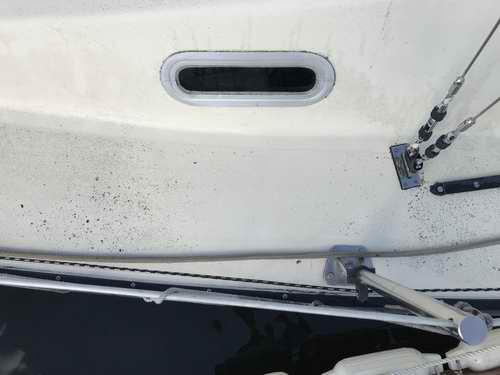 CLEAN THE DECK WITH "30 SECONDS" - Cleans and removes slimy green and slippery black algae, moss, mildew and in Panache's case, some coal dust. Spray "30 SECONDS" on a dry deck and keep it wet with a second spray application followed by a light scrubbing. Rinse with water to stop the chemical cleaning action. Put on your sun glasses cause the deck is gonna be bright! CLEAN THE DECK WITH "30 SECONDS" - Cleans and removes slimy green and slippery black algae, moss, mildew and in Panache's case, some coal dust. Spray "30 SECONDS" on a dry deck and keep it wet with a second spray application followed by a light scrubbing. Rinse with water to stop the chemical cleaning action. Put on your sun glasses cause the deck is gonna be bright!
-
Panache had 30+ years of coal dust mixed with black algae imbedded deep in the dimples of the non-skid. It was difficult to keep ahead of the dust with a coal mine on either side of the lake. One day I resolved to rid the deck of it by soaking the surface with Fantastic. The spray cleaner contains bleach and has always been my go to cleaner. After 2 hours of scrubbing I thought the deck looked quite good. That is until a club member arrived to spray "30 Seconds" on a cleaned area. I was sceptical and then amazed as I watched it dissolve the remaining imbedded stuff within 2 minutes. Then I gave it a light brushing followed by a rinse and it was whistle clean. You can see the test area below the window at right. Going to need sun glasses now that I cleaned the rest of the deck back to the factory colour. Within a week about 20 guys from various clubs around the lake achieved the same results with their bottle of "30 Seconds."
Me and my big mouth! Needless to say, "30 Seconds" is now my go to deck cleaner.
NOTE - "30 Seconds" can be safely used on Sunbrella to remove bird poo, etc. The colour of Sunbrella is in the thread when it is manufactured. "30 Seconds" is NOT safe to use on a fabric that is dyed since it can dissolve the surface dye.
CLEAN A LOCKER (Mildew) - If the Fantastic you buy
contains bleach it can easily kill and remove mildew. Simply spray on, wipe the mold with a damp rag and let dry. See Tech Tip B02.
See Note 1: Be forewarned, bleach fumes are noxious especially if your head is stuck into an enclosed locker or such. Provide lots of fresh air ventilation. Come up for fresh air every minute or so. CLEAN THE BOTTOM (Pressure Washer) - Pressure wash the hull before waxing or
using other cleaners to see the true bright color of your gel
coat.
Also great on lifelines, fenders, stainless steel, shroud covers and to remove old Armada finish. Careful of the high pressure (1000 psi) from the nozzle. I watched a friend of mine go right through the dirt of his Westerly 26,
then the paint and finally through the
gel coat. I don't know what pressure that pump was set for, but it
worked like a belt sander. So keep the nozzle moving and back off from the surface to use the
minimum force required to clean the hull. 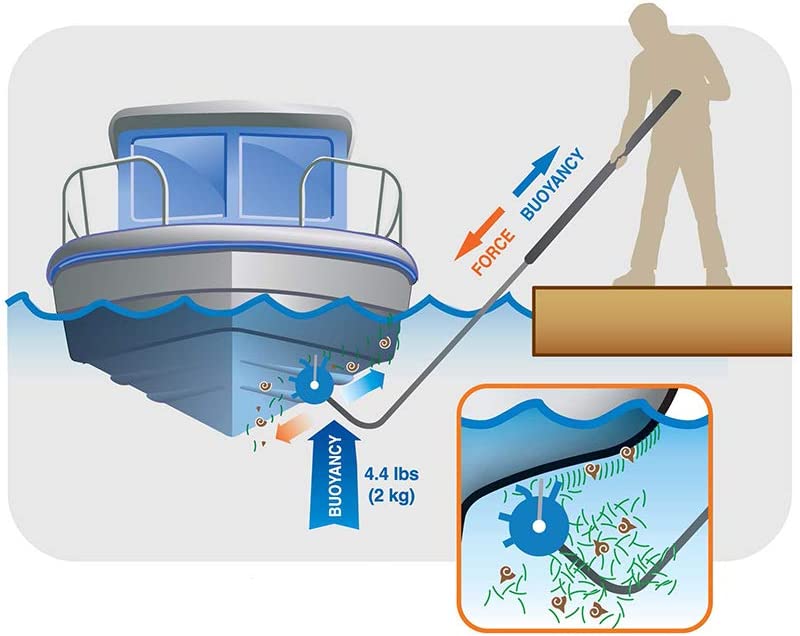 CLEAN THE BOTTOM (Boat Floating, 2021) - I used my new Scrubbis Brush to clean Panache's bottom just before end of season haul out. The >2Kg of buoyancy of the brush pushes against the hull as you slide it across the bottom. The brush is reversible from 3 foam blades to 1 vinyl blade and a foam blade. I used the latter combination from the dock thinking it to be the most aggressive to remove the grunge from floating in warm shallow water over the season. Once I retrieved Panache from the water I had a pleasant surprise. Her hull has never been this smooth at the end of a season. It feels like it was sanded smooth with 200 grit paper. One cleaning totally removed several seasons of wet slime and grunge with minimal effort. It was much cleaner than power washing in a truck wash ever did. Less hassle too. Granted it is a lot easier to remove slime and grunge while the hull is still wet, but that is the best time.
I'm sure glad I found this
brush. I will likely dispense with using anti-fouling paint in the future. CLEAN THE BOTTOM (Boat Floating, 2021) - I used my new Scrubbis Brush to clean Panache's bottom just before end of season haul out. The >2Kg of buoyancy of the brush pushes against the hull as you slide it across the bottom. The brush is reversible from 3 foam blades to 1 vinyl blade and a foam blade. I used the latter combination from the dock thinking it to be the most aggressive to remove the grunge from floating in warm shallow water over the season. Once I retrieved Panache from the water I had a pleasant surprise. Her hull has never been this smooth at the end of a season. It feels like it was sanded smooth with 200 grit paper. One cleaning totally removed several seasons of wet slime and grunge with minimal effort. It was much cleaner than power washing in a truck wash ever did. Less hassle too. Granted it is a lot easier to remove slime and grunge while the hull is still wet, but that is the best time.
I'm sure glad I found this
brush. I will likely dispense with using anti-fouling paint in the future.
- This is the link to a Buy Scrubbis in North America. Easier to understand than the Swedish web site where it is manufactured.
CLEAN THE BOTTOM (Dried Sea Weed or Dead Things from below) - Every once in a while
a tiny critter slithers out of the water or is splashed against the hull to get baked
under the sun. Scrubbing with a stiff bristle and water usually removes them. The more stubborn ones are easy to remove with a Scotch Brite pad and
water. CLEAN THE BOTTOM (Soap Scum from Water) - If you haul the boat out late in
the Fall after motoring down the lake for 20 KMs you may discover that
"soap scum" from the water has left an ugly brown stain
that follows the bow and quarter waves.
It is advised to remove this ASAP because leaving it will ensure lots
of elbow grease if you remove it later. The only solution I could
find to soften it was "Pink Stuff" (industrial degreaser) or Lysol Gel
toilet bowl cleaner. The "Pink Stuff" worked slightly better
but is more difficult to find. Where the elbow grease comes in is scrubbing the hardened stain off
with a 3M heavy duty stripping tool (a scouring pad with course Scotch Brite). Stop scrubbing when it gets easy otherwise you will go
through the gel coat. Scrubbing was the only way I could
remove the 2 year old scum. CLEAN THE BOTTOM (Dirty Rub Rail) - Use acetone and a Scotch Brite pad to clean the vinyl insert of
a rub rail. Then apply two coats of Penatrol to preserve the vinyl
which also puts a nice shine on it. I use the same rubbing compound to
restore gel-coat, etc. Cleans the rub rail and is very easy to use. Then coat it with the same wax that you put on the boat. Looks great. CLEAN STAINLESS STEEL (Pulpit & Pushpit) - (Clean & Preserve).
| To remove
rust from stainless steel tubing use "Bar Keepers Friend". Mix the powder in water, make a paste, rub with Scotch Brite pad and rinse off. It does an immaculate job. The main component is oxalic acid that occurs naturally in rhubarb. The before and after photos speak for themselves. 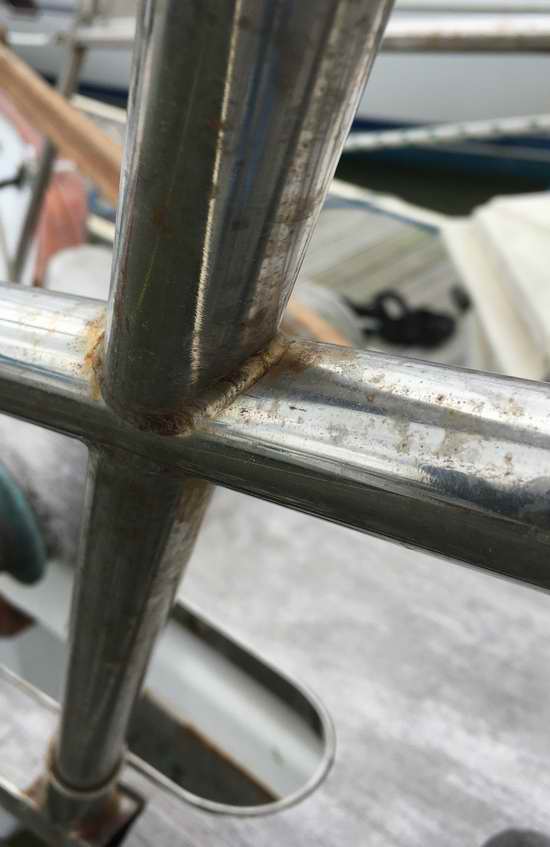
| 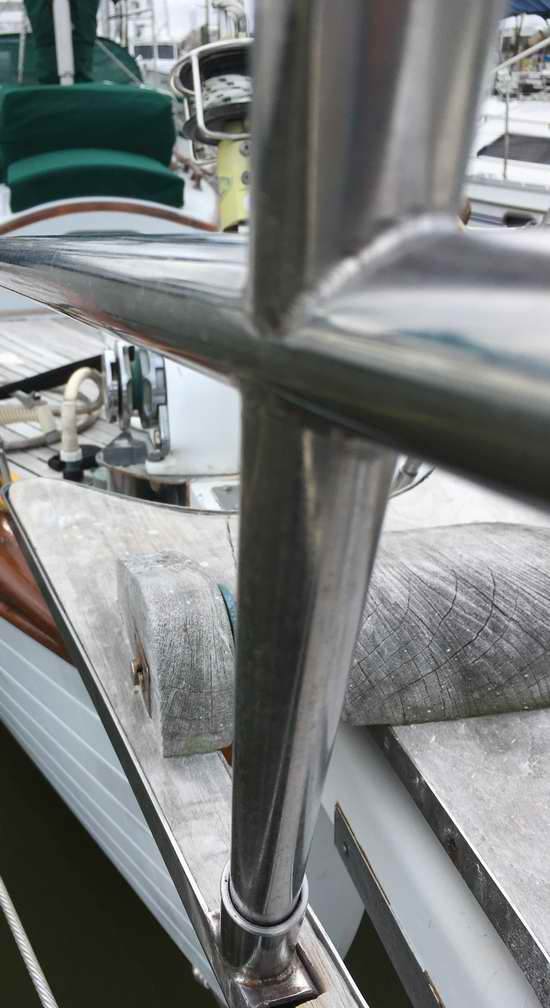
|
CLEAN STANDING RIGGING (Preserve) - SS standing rigging may look great covered with plastic shroud covers, but the
covers should be removed occasionally to kill the growth that develops
underneath. Similarly with SS Lifelines, and antennas. Stainless steel MUST be exposed to air to remain stain
free! Use any mild soap to kill the growth. FIBREGLASS (Spilled Diesel Fuel) - Use Rubbing Alcohol to clean up minor diesel
fuel spills and to eliminate the smell. FIBREGLASS (Mildew) - A 50:50
solution of vinegar and hydrogen peroxide will kill mould or mildew (or any other growth for that
matter) in porous material, wood, fabric or in a fissure. FIBREGLASS (Rust Stains) - To remove rust from
fibreglass use
Lime-Away or Bar Tenders Friend. I have seen the "Bar Tender" do
an immaculate job. Mix the powder in water, make a paste, rub
with Scotch Brite pad and rinse off. FIBREGLASS (Silicone Spray Lubricant) - Over sprayed silicone spray lubricant prevents paint from sticking to a surface. This is the primary cause of fish eyes (small circular paint free areas). Mask
off areas you may be painting in the future. FIBREGLASS (Vinyl Decals) - Really old decals are difficult to remove. The longer they have been exposed to
the sun the harder they are to remove. Apply heat with a heat gun,
moving it constantly to avoid over heating. Pry up a corner and
gently pull up. You will likely have to use a razor blade in a holder
to assist with "lifting" it off. Chemicals generally don't
work because the front of the decal is sealed to water ingress. Good
luck. PROPELLER (Keep the barnacles off) - Smear a very light coat
of axle grease on the
prop blades to keep the barnacles from sticking.
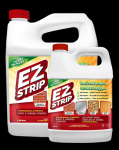 REMOVE FRESH SEALANT AROUND NEWLY BEDDED HARDWARE - Saturate a fresh paper towel with WD40 and wipe off the excess sealant. No need to mask off the deck around the fitting. REMOVE FRESH SEALANT AROUND NEWLY BEDDED HARDWARE - Saturate a fresh paper towel with WD40 and wipe off the excess sealant. No need to mask off the deck around the fitting.
REMOVE HARDENED SIKKENS CETOL - EZ Strip varnish remover can dissolve hardened Cetol Marine.
Its available from Home Depot. Just paint it on, wait 15 minutes
and scrape it off. Use a carbide tipped cabinet
scraper as it will last longer than a metal one. The problem with sanding is that the
removed Cetol Marine clogs the paper. If you are scraping be careful of the corners, they might leave a gouge. I don't have personal experience with removing Cetol but the
suggestion from the local Sikkens Technical representative is,
"Maintain the coating. Don't let it deteriorate to expose the
raw wood or you will have to start all over again."
Fortunately a maintenance coat is dead easy. REMOVE CURED SEALANT (3M 5200 / 4200, Sikaflex 291 or Adhesive - DeBond Marine Formula is specifically formulated to remove cured polyurethane adhesives marketed as forming a permanent bond. It can remove old deck hardware, transducers and thru hull fittings, breaking the bond in minutes. It is safe on fibreglass, gel coat, powder coated metal, aluminum, 2 part paint, polycarbonate lenses, and clear coat finish. When done, simply clean up with soap and water to neutralize DeBond Marine, then wipe down with denatured alcohol. (Not sold in Canada). REMOVE CURED BoatLIFE POLUSULFIDE SEALANT - BoatLIFE Life-caulk is designed to release a cured bond around a thru hull fitting. Best to pick away at the sealant around the fitting to create a depression for the liquid to penetrate. Or build a dam of plastercine around the fitting to contain the liquid. Once enough of the sealant has weakened you can start twisting the fitting to loosen it. (Sold in Canada). REMOVE THE SMELL OF VOMIT - Use a weak solution (a handful in a quart of water) of Baking Soda (Sodium Bicarbonate) to remove the smell of
vomit, toilet
smells (human or pet) or any similar odours.
Store the soda in a moisture proof container. Its wise to plug your nose and breath through your mouth while doing this job. The smell can set you off.
_________________________________ "SAFETY WARNINGS" ____________________________________
DON'T MIX A SOAP THAT CONTAINS BLEACH WITH ANOTHER SOAP RO DETERGENT. Bleach is a very powerful chemical, capable of all kinds of reactions so DON'T mix it! For example, NEVER, NEVER, EVER, mix bleach (contains a "hypochlorite") and
an "ammoniated" cleanser.
Bleach plus ammonia yields free chlorine gas, which is a nasty
way to die). TO KILL MILDEW USE A SOAP THAT CONTAINS BLEACH & WEAR GLOVES WITH MASK. The bleach
kills the bacteria and the suds prevent bacteria from becoming air borne
so you don't breathe it in. The mask helps to stop air borne droplets from entering your lungs. -
POLLUTING WATER. While
many of the cleaning suggestions are low impact to the environment, it is
prudent to perform these jobs when the boat is on land, NOT on water.
The life forms in water CANNOT tolerate cleaning chemicals, while the life forms on
land can at least get away from the chemicals. We have no business destroying their
environment so think about what you are going to do!
|


 CLEAN THE BOTTOM (Boat Floating, 2021) - I used my new Scrubbis Brush to clean Panache's bottom just before end of season haul out. The >2Kg of buoyancy of the brush pushes against the hull as you slide it across the bottom. The brush is reversible from 3 foam blades to 1 vinyl blade and a foam blade. I used the latter combination from the dock thinking it to be the most aggressive to remove the grunge from floating in warm shallow water over the season. Once I retrieved Panache from the water I had a pleasant surprise. Her hull has never been this smooth at the end of a season. It feels like it was sanded smooth with 200 grit paper. One cleaning totally removed several seasons of wet slime and grunge with minimal effort. It was much cleaner than power washing in a truck wash ever did. Less hassle too. Granted it is a lot easier to remove slime and grunge while the hull is still wet, but that is the best time.
I'm sure glad I found this
brush. I will likely dispense with using anti-fouling paint in the future.
CLEAN THE BOTTOM (Boat Floating, 2021) - I used my new Scrubbis Brush to clean Panache's bottom just before end of season haul out. The >2Kg of buoyancy of the brush pushes against the hull as you slide it across the bottom. The brush is reversible from 3 foam blades to 1 vinyl blade and a foam blade. I used the latter combination from the dock thinking it to be the most aggressive to remove the grunge from floating in warm shallow water over the season. Once I retrieved Panache from the water I had a pleasant surprise. Her hull has never been this smooth at the end of a season. It feels like it was sanded smooth with 200 grit paper. One cleaning totally removed several seasons of wet slime and grunge with minimal effort. It was much cleaner than power washing in a truck wash ever did. Less hassle too. Granted it is a lot easier to remove slime and grunge while the hull is still wet, but that is the best time.
I'm sure glad I found this
brush. I will likely dispense with using anti-fouling paint in the future. 

 REMOVE FRESH SEALANT AROUND NEWLY BEDDED HARDWARE - Saturate a fresh paper towel with WD40 and wipe off the excess sealant. No need to mask off the deck around the fitting.
REMOVE FRESH SEALANT AROUND NEWLY BEDDED HARDWARE - Saturate a fresh paper towel with WD40 and wipe off the excess sealant. No need to mask off the deck around the fitting.